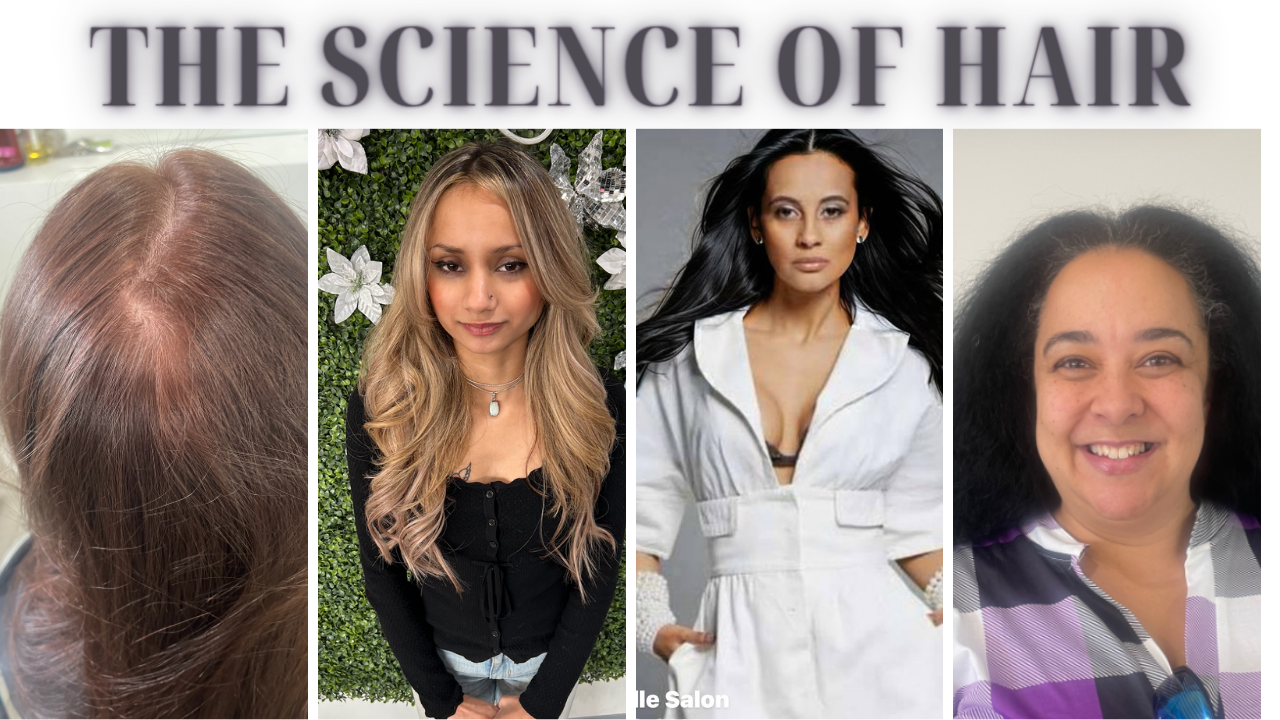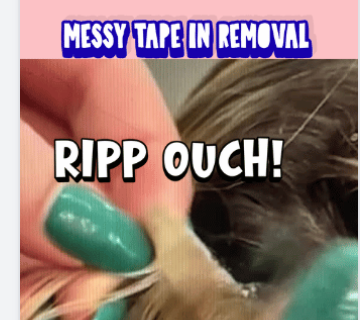Hair Science: Types & Textures Explored
Welcome to the fascinating world of hair science! Our hair is an essential part of our identity and plays a significant role in how we express ourselves. From the color and texture to its thickness and growth patterns, hair varies greatly from person to person. In this blog, we will explore the different types and textures of hair, delve into the science behind them, and uncover some common misconceptions about hair care. Whether you have straight, curly, thin, or thick hair, understanding its unique characteristics will help you embrace and care for your locks more effectively.

Understanding Hair Science
To truly appreciate the diversity of hair types and textures, it’s essential to grasp the underlying principles of hair science. Each strand of hair is formed by a biological structure called the hair follicle, which resides in the deep layers of our skin. The follicle produces hair shafts, made up of a protein called keratin, which grows out of the scalp. The medulla, cortex, and cuticle are the three layers that make up the hair shaft. The medulla, located at the center of the hair, is responsible for providing structure, while the cortex gives hair its color and strength. The cuticle, a thin, protective layer, covers the hair shaft and acts as a shield against damage and moisture loss.

The Biological Structure of Hair
The structure of each hair shaft and follicle is determined by our genetic makeup, resulting in the wide range of hair types and textures observed in different individuals. For example, thick hair tends to have a larger number of hairs, and each strand is generally wider in diameter, giving it a fuller and denser appearance. On the other hand, thin hair has a lower hair density, and the scalp may be more visible as a result. Curly hair is characterized by an irregular curl pattern, and straight hair has a smooth, straight texture.

How Does Hair Grow?
Hair growth follows a cycle that consists of three different phases: anagen, catagen, and telogen. During the anagen phase, hair actively grows and cells in the hair follicle are dividing rapidly. This phase can last for several years, contributing to the length of the hair. The catagen phase is a transitional phase, where hair growth stops, and the follicle shrinks. Finally, during the telogen phase, the hair follicle remains at rest, and hair naturally falls out to make room for new hair growth.
Both genetic factors and selective pressure play a role in determining the length and thickness of hair, as well as the duration of each growth phase. Various genes and populations exhibit different hair growth patterns, which result in the diversity of hair types and textures that we observe.

Exploring Different Hair Types
Understanding the different hair types is the key to effectively managing and styling our hair. Hair type refers to the overall structure and texture of an individual's hair, and it is typically classified into several categories. Common hair types include straight hair, curly hair, thick hair, and thin hair. Each hair type requires unique care and styling techniques to maintain its health and appearance. Let's take a closer look at each type and explore some tips for managing and enhancing their natural qualities.
Thick Hair
Thick hair is characterized by an abundance of hair and a larger hair shaft diameter. Individuals with thick hair often enjoy a voluminous and robust mane. The genetic makeup of an individual, including factors such as the number of hairs and hair thickness, contributes to the appearance of thick hair. However, individuals with thick hair may also experience unique challenges, such as longer drying times and difficulty managing frizz and unruly strands. Understanding the structure and genetics of thick hair can help individuals effectively care for and style their hair.
Thin Hair
On the other end of the spectrum, thin hair is characterized by a lower hair density and a thinner hair shaft diameter. Individuals with thin hair may experience challenges related to hair loss, breakage, and the visibility of their scalp. However, thin hair also has its advantages, such as being lightweight and easy to style. Proper care and styling techniques, including choosing suitable hair products and avoiding excessive heat and chemical treatments, can help individuals with thin hair maintain its health and enhance its appearance.
Curly Hair
Curly hair is known for its distinctive curl pattern and texture. The genetic factors and hair morphology determine the shape and structure of each curl, resulting in a wide range of curl types, from loose waves to tight coils. While curly hair can be stunning and glamorous, it also requires specific care and attention to maintain its health and manage frizz. Here are some important tips for curly hair care:
- Embrace moisture: Curly hair tends to be drier and more prone to frizz. Regular deep conditioning treatments and moisturizing hair products can help prevent dryness and enhance the curl pattern.
- Avoid excessive heat and styling: Heat styling tools can strip curly hair of moisture and lead to damage. Embrace natural hairstyles and limit the use of heat styling tools to protect the health of your curls.
- Use products for curly hair: Look for hair care products specially formulated for curly hair, such as curl-enhancing creams, leave-in conditioners, and frizz-fighting serums.
- Protect hair during sleep: To preserve and protect your curls, consider using a satin or silk pillowcase, or wrap your hair in a silk scarf, to minimize friction and frizz while you sleep.
Straight Hair
Straight hair is characterized by its smooth, straight texture and lack of curl or wave. The hair shaft of straight hair is typically round, and it tends to be more resilient and less prone to breakage compared to other hair types. While straight hair may appear relatively low-maintenance, it still requires proper care and attention to maintain its health and shine. Regular shampooing, conditioning, and protecting straight hair from excessive heat styling and sun exposure can help keep it looking and feeling its best.
Textures of Hair
In addition to hair types, hair texture refers to the thickness and coarseness of each hair strand. Hair texture falls into three main categories: fine, medium, and coarse. Understanding the texture of your hair can help you select appropriate styling products and techniques for optimal hair health and styling. Let's explore each hair texture and its unique characteristics.
Fine Hair Texture
Fine hair is characterized by a smaller hair strand diameter and a delicate texture. The individual strands of fine hair are generally more fragile and prone to breakage than other hair types. Fine hair can lack volume and body, and it may be more susceptible to oiliness and scalp issues. To care for fine hair effectively, it's important to choose lightweight, volumizing hair products that add body without weighing the hair down. Avoid heavy, oil-based products that can make fine hair appear flat and greasy.
Medium Hair Texture
Medium hair texture falls between fine and coarse hair and is often considered the most versatile hair type. It has a balanced thickness and strength, making it less prone to breakage and damage. Medium hair texture generally maintains a healthy elasticity, allowing for different styling options. Individuals with medium hair texture can experiment with various hairstyles and products without compromising the hair's health. Keeping the hair moisturized, protecting it from heat, and avoiding harsh chemical treatments will help maintain the hair's natural strength and flexibility.
Coarse Hair Texture
Coarse hair texture is characterized by thick hair strands and a robust, sturdy nature. Coarse hair tends to be stronger and more resilient, but it is also prone to dryness and frizz. The hair strand itself is larger in diameter, giving it a fuller appearance and texture. Due to its thickness, coarse hair may require extra moisture and hydration to keep it healthy and manageable. Using rich, nourishing hair care products and regular deep conditioning treatments can help maintain moisture and minimize frizz for individuals with coarse hair texture.
Factors Affecting Hair Health
The health of our hair is influenced by various factors, including genetic factors, hormonal changes, and the role of vitamins and nutrients. Understanding these factors is crucial for maintaining healthy and vibrant hair. Let's explore some key factors that play a major role in hair health.
Role of Vitamins in Hair Health
Vitamins play an essential role in promoting healthy hair growth and maintaining hair health. Here are some key vitamins that contribute to vibrant and luscious hair:
- Biotin: Biotin, also known as Vitamin B7, is often associated with healthy hair growth. It aids in the production of keratin, the protein that makes up our hair strands.
- Vitamin D: Adequate levels of Vitamin D are necessary for healthy hair follicles and hair growth.
- Vitamin E: Vitamin E helps improve blood circulation, which promotes healthy hair growth and scalp health.
- Vitamin C: Vitamin C supports the production of collagen, an important component of hair structure and strength.
- B Vitamins: B vitamins, including B12 and B6, help nourish the hair follicle and scalp, promoting healthy hair growth.
- Vitamin K: While not directly linked to hair growth, Vitamin K aids in overall hair health and prevents hair loss.

Impact of Hormonal Changes on Hair
Hormonal changes can have a significant impact on hair health, including hair loss and changes in hair texture. Here are some ways hormonal fluctuations can affect our hair:
- Estrogen and Progesterone: Fluctuations in estrogen and progesterone levels can affect hair texture, thickness, and the growth cycle of hair follicles.
- Testosterone and DHT: Testosterone and its derivative, dihydrotestosterone (DHT), can impact hair growth and follicle health. Elevated levels of DHT have been linked to hair loss and thinning hair in both men and women.
- Thyroid Hormones: Imbalances in thyroid hormones, such as hypothyroidism or hyperthyroidism, can lead to changes in hair texture and hair loss.
- Pregnancy and Menopause: Hormonal changes during pregnancy and menopause can alter hair texture and may contribute to hair thinning or hair loss.
Common Hair Myths Debunked
There are many myths and misconceptions surrounding hair care that can lead to confusion and improper care. Let's debunk some of the most common hair myths:
- Myth 1: Cutting hair frequently makes it grow faster and thicker. In reality, hair growth occurs at the follicle, and regular trims only prevent split ends and breakage, giving the appearance of healthier and smoother hair.
- Myth 2: Shampooing hair every day is necessary for cleanliness. However, excessive shampooing can strip the scalp and hair of natural oils, leading to dryness and potential damage. The frequency of shampooing should be tailored to individual hair types and needs.
- Myth 3: Trimming hair makes it grow faster. While trims can help maintain hair health by preventing split ends and breakage, they do not accelerate hair growth itself.
- Myth 4: Hair color determines its strength, texture, and rate of growth. The color of our hair is determined by genetic factors, and while different hair colors may have different genetic characteristics, they do not determine hair health, texture, or growth rate.
- Myth 5: Brushing hair 100 strokes a day promotes hair growth. Excessive brushing can actually damage the hair shaft and lead to breakage. Gentle and mindful brushing, using appropriate hairbrushes, is sufficient for maintaining hair health.
Guide to Care for Different Hair Types & Textures
Caring for different hair types and textures requires an understanding of their unique needs and characteristics. Here's a guide to effective hair care for each type:
- Coily hair: Regular deep conditioning and moisture are crucial for maintaining the curl pattern and preventing breakage. Protective styling and avoiding heat styling tools can also help preserve the natural curl.
- Curly hair: Look for sulfate-free shampoos and products that enhance moisture retention. Proper styling techniques, such as the use of diffusers and embracing natural hairstyles, help maintain curl definition and minimize frizz.
- Straight hair: Opt for lightweight, non-greasy conditioners and heat protectants to keep straight hair healthy and protected from styling damage. Avoid excessive heat styling and be mindful of scalp health.
- Fine hair: Use volumizing products and avoid heavy, oil-based hair care products that can weigh down fine hair. Regular trims and avoiding excessive heat and chemical treatments can help prevent breakage.
- Medium hair: Medium hair texture is versatile and resilient, making it easier to manage and style. Regular moisture and scalp care, along with heat and UV protection, support overall hair health.
- Coarse hair: Focus on maintaining moisture and hydration in coarse hair. Deep conditioning treatments, leave-in conditioners, and protective styling can help combat dryness and frizz.
Is There a Direct Relation Between Hair Type and Hair Health?
While different hair types have specific care needs, hair health is influenced by various factors, and it's important to note that hair type alone does not determine overall hair health. Genetic factors and individual variations play a significant role in hair type, texture, and overall health. Some key factors that contribute to hair health include genetics, scalp health, hair care routine, and external factors such as styling practices, diet, and overall health.
No matter what hair type you have, maintaining a healthy scalp, addressing any hair concerns promptly, and adopting an appropriate hair care routine are vital for promoting optimal hair health. By understanding and embracing the characteristics of your own hair type, you can create a personalized hair care routine that caters to your unique hair needs and enhances its natural beauty.

Conclusion
Understanding the science behind different hair types and textures is crucial for effective hair care. By recognizing the biological structure of hair and how it grows, you can tailor your hair care routine to meet its specific needs. Whether you have thick, thin, curly, or straight hair, understanding your hair type allows you to choose the right products and styling techniques. Additionally, factors like vitamins and hormonal changes play a significant role in hair health. By debunking common hair myths and following a personalized hair care routine, you can maintain healthy and beautiful hair. Remember, there is no direct relation between hair type and hair health; it's all about understanding and nurturing your unique strands. So embrace your hair's natural texture and give it the care it deserves!









